Wikipedia:Picture of the day/December 2019
|
Featured picture tools: |
These featured pictures, as scheduled below, appeared as the picture of the day (POTD) on the English Wikipedia's Main Page in December 2019. Individual sections for each day on this page can be linked to with the day number as the anchor name (e.g. [[Wikipedia:Picture of the day/December 2019#1]] for December 1).
You can add an automatically updating POTD template to your user page using {{Pic of the day}} (version with blurb) or {{POTD}} (version without blurb). For instructions on how to make custom POTD layouts, see Wikipedia:Picture of the day.
December 1

|
The black-chested snake eagle (Circaetus pectoralis) is a large African bird of prey in the family Accipitridae. It resembles other snake eagles and was formerly considered conspecific with the short-toed and Beaudouin's snake eagles, to which it is closely related. As well as feeding on snakes, which may be swallowed while still alive, it feeds on lizards, small mammals, frogs and insects. It typically perches in an elevated position ready to swoop silently to capture its prey, before returning to its perch to eat. This picture shows a black-chested snake eagle swallowing a snake, photographed in Awash National Park, Ethiopia. Photograph credit: Charles J. Sharp
Recently featured:
|
December 2

|
Golden Summer, Eaglemont, is an 1889 oil-on-canvas landscape painting by Australian artist Arthur Streeton. Painted en plein air at the height of a summer drought, it depicts a sunlit, undulating plain, stretching away to the distant blue Dandenong Ranges, outside Melbourne. In 1892, it became the first painting by an Australian-born artist to be exhibited at London's Royal Academy of Arts. Regarded as a masterpiece of Australian impressionism, it is currently on display at the National Gallery of Australia in Canberra, which acquired the painting in 1995 for A$3.5 million, a record price for an Australian painting at that time. Painting credit: Arthur Streeton
Recently featured:
|
December 3

|
Samuel Dexter (1761–1816) was an early American statesman who served both in Congress and in the cabinets of Presidents John Adams and Thomas Jefferson. Dexter served in the U.S. House of Representatives from 1793 to 1795, and then in the U.S. Senate from 1799 to 1800, for less than a year. President Adams appointed him secretary of war in 1800, and later as the third secretary of the treasury, serving in the latter role for four and a half months in 1801. This picture is a line engraving of Dexter, produced around 1902 by the Department of the Treasury's Bureau of Engraving and Printing (BEP), as part of a BEP presentation album of the first 42 secretaries of the treasury. This engraving shows him wearing a dark coat over a frilled shirt and cravat, garments that were fashionable during his lifetime. Engraving credit: Bureau of Engraving and Printing; restored by Andrew Shiva
Recently featured:
|
December 4
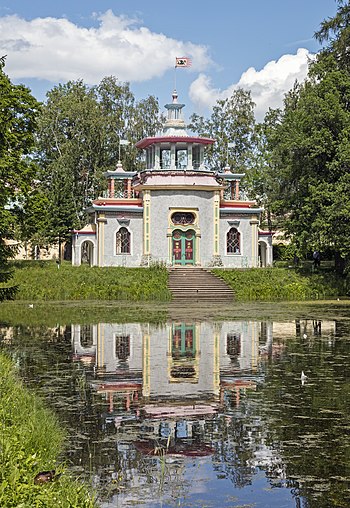
|
The Creaking Pagoda or Chinese Summer-House is located in Tsarskoye Selo, outside Saint Petersburg, Russia, between two ponds on the boundary separating the Catherine Park of the Baroque Catherine Palace and the New Garden of the neoclassical Alexander Palace's Alexander Park. The pagoda, designed by Georg von Veldten, is a folly that resulted from the 18th-century taste for Chinoiserie. The walls are decorated with figures of dragons and other stylized Chinese motifs. Construction lasted from 1778 to 1786, and the structure was restored from 1954 to 1956. The name of the structure refers to a characteristic sound produced by a metal weathervane, shaped like a banner, on the top of the structure, which creaks when it is turned by the wind. Photograph credit: Andrew Shiva
Recently featured:
|
December 5

|
|
The Hunting of the Snark is a nonsense poem written by English writer Lewis Carroll between 1874 and 1876. The poem describes a ship with a crew of ten trying to find the Snark, an animal which may turn out to be a highly dangerous Boojum. Among the hunters is a lace-making beaver, and a butcher, whose only skill is in butchering beavers. This picture, the third of Henry Holiday's original illustrations for the poem, accompanies the following stanza:
Illustration credit: Henry Holiday; restored by Adam Cuerden
Recently featured:
|
December 6

|
Calliphora vicina is a species in the family Calliphoridae, the blow flies. The species is particularly important in the field of forensic entomology due to its consistent time of arrival and colonization of the body following death. This picture is a macro photograph of the head of a C. vicina fly. The head is dominated by a pair of large compound eyes, each composed of several thousand light-receiving units known as ommatidia, arranged in a hexagonal pattern. The ommatidia are elongated and rod-shaped, and are oriented perpendicular to the surface of the eye; each has its own lens and photoreceptor cells. The brain combines the points of light from each of the ommatidia to form a mosaic image. Also visible in the picture are various bristles, pedipalps and mouthparts. Photograph credit: USGS Bee Inventory and Monitoring Laboratory
Recently featured:
|
December 7

|
|
Khor Virap is a monastery of the Armenian Apostolic Church, located on the Ararat Plain in Armenia, near the closed border with Turkey, and about 8 kilometres (5 mi) south of the city of Artashat, within the territory of ancient Artaxata. Shown here with Mount Ararat in the background, it is one of the most visited pilgrimage sites in Armenia. Its fame is attributed to the fact that Gregory the Illuminator, the religious leader who converted Armenia from paganism to Christianity in 301, was imprisoned in the location for fourteen years by King Tiridates III. A chapel was initially built in 642 by Nerses III the Builder as a mark of veneration for Saint Gregory. Over the centuries, the monastery was repeatedly rebuilt; the current buildings date from 1662. Photograph credit: Diego Delso
Recently featured:
|
December 8

|
Dustin Brown (born 8 December 1984) is a Jamaican-German professional tennis player. He rose to fame after beating Rafael Nadal in the 2014 Halle Open and the 2015 Wimbledon Championships, and is known for his technique, speed and entertaining playing style. This picture of Brown was taken during the third round of the 2015 Wimbledon qualifying tournament. Having earned himself a place in the main championships, he caused a major upset in the second round by defeating Nadal, who had won the men's singles title on two previous occasions, but was beaten by Viktor Troicki in the third round. Photograph credit: David Iliff
Recently featured:
|
December 9

|
The Savage State is the first in a series of five paintings entitled The Course of Empire, created by American artist Thomas Cole between 1833 and 1836. The series depicts the growth and fall of an imaginary city, situated on the lower end of a river valley. This first painting shows the scenery before the civilizing influence of men change the landscape. A hunter clad in skins runs through the wilderness pursuing a fleeing deer, canoes paddle up the river and a few tipis cluster around a campfire. The visual references are those of aboriginal North American life, and the painting depicts the ideal state of the natural world, serene and unspoiled by humanity. Painting credit: Thomas Cole
Recently featured:
|
December 10

|
The snowy egret (Egretta thula) is a small member of the heron family, Ardeidae, native to the Americas, where it has a widespread distribution. The bird forages for fish, frogs, crustaceans, insects and worms in marshes and shallow water habitats, applying various techniques to persuade the prey to reveal itself. A sociable species, it often forages in mixed species groups, and nests in the company of other herons and egrets. The bill is specially adapted for probing and stabbing. This picture shows a snowy egret photographed at Las Gallinas Wildlife Ponds, near San Rafael, California. Photograph credit: Frank Schulenburg
Recently featured:
|
December 11
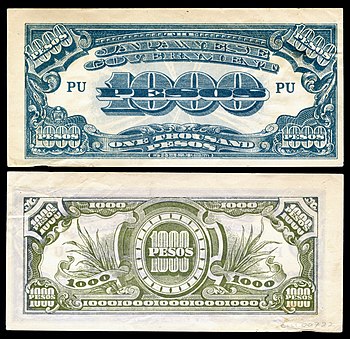
|
The Japanese government-issued Philippine peso was a form of fiat money issued in the Philippines by the Japanese government during World War II as part of its occupation of the archipelago. The first issue in 1942 had notes valued at 1, 5, 10 and 50 centavos, and 1, 5 and 10 pesos. A new series of peso denominations were issued in 1943, and hyperinflation resulted in a further issue in 1944, with the higher value notes of 100 and 500 pesos being added. This picture shows the obverse (top) and reverse (bottom) sides of a 1000-peso note that was issued in 1945, shortly before the country was liberated by Allied troops. The banknote is in the National Numismatic Collection of the Smithsonian Institution's National Museum of American History. Banknote credit: Empire of Japan; photographed by Andrew Shiva
Recently featured:
|
December 12
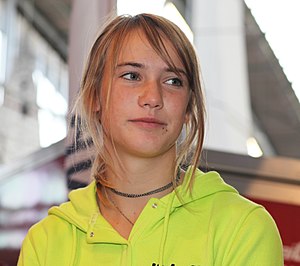
|
Laura Dekker (born 1995) is a New Zealand–born Dutch sailor who completed a solo circumnavigation of the globe in a 12.4-metre (41-foot) two-masted ketch from 2010 to 2012. Dekker was fourteen years old when she set off from Gibraltar rather than the Netherlands, because the Dutch shipping regulations did not permit anyone under the age of sixteen to skipper a boat of that size in Dutch waters. After crossing the Atlantic Ocean, she started her record-breaking attempt from Sint Maarten in the Caribbean, passing through the Panama Canal and traversing the Pacific, Indian and Atlantic Oceans before completing her circumnavigation back at Sint Maarten. This picture shows Dekker attending the 2011 Hiswa Boat Show in Amsterdam. Photograph credit: Savyasachi, retouched by ukexpat
Recently featured:
|
December 13

|
Flowers in a Terracotta Vase is a still life painting by the Dutch artists Albertus Jonas Brandt and Eelke Jelles Eelkema. It was painted in oils on a maple wood panel by Albertus Jonas Brandt, but had not been completed at the time of his death from tuberculosis in 1821. After being purchased by the Museum van Levende Nederlandsche Meesters in an unfinished state, it was completed by Eelke Jelles Eelkema the following year. The painting was later transferred to the Rijksmuseum in Amsterdam where it remains. Painting credit: Albertus Jonas Brandt and Eelke Jelles Eelkema
Recently featured:
|
December 14

|
Alabama, in the southeastern United States, was admitted as the 22nd state of the union on December 14, 1819. This picture is a historical depiction of the coat of arms of Alabama, as illustrated by American engraver Henry Mitchell in State Arms of the Union, published in 1876 by Louis Prang. It depicts a bald eagle with wings raised, perching on a national shield with stars and stripes. The eagle's foot grasps three arrows and its beak holds a streamer with the motto "Here we rest", a reference to the state being known as "the land of rest". This design is also featured in the seal of Alabama, which was adopted on December 29, 1868. Illustration credit: Henry Mitchell; restored by Andrew Shiva
Recently featured:
|
December 15

|
The marsh fritillary (Euphydryas aurinia) is a butterfly of the family Nymphalidae. Commonly distributed in the Palearctic region, the marsh fritillary's common name derives from one of its habitats, marshland. The larval stage lasts seven to eight months and includes a period of hibernation over the winter. The larvae are dependent on the host plant, Succisa pratensis, not only for food but also for shelter during the hibernation stage. Females lay eggs in batches on the host plant and are, like other batch-layers, selective about location because offspring survivorship levels for batch-layers are highly dependent on location selection. This picture shows the underside of a female marsh fritillary, photographed near the English village of Lydlinch, Dorset. Photograph credit: Charles J. Sharp
Recently featured:
|
December 16
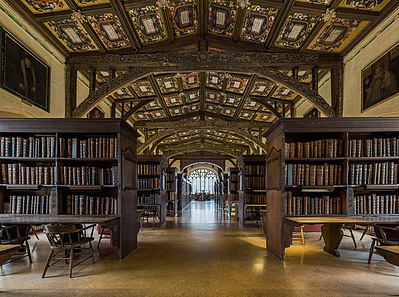
|
Duke Humfrey's Library is the oldest reading room in the Bodleian Library at the University of Oxford. It is named after Humphrey, Duke of Gloucester, a connoisseur of literature, who donated his collection of 281 books to the university at his death in 1447. Books were hand-written at the time and his legacy was considered an extraordinarily generous donation, since the university previously had only 20 books. Only three books from the original donation remain, the rest having been removed in 1550 and probably burnt during the Reformation. The library was restored and restocked by Thomas Bodley from 1598 onwards. The books in the oldest part of the library are accommodated in oak bookcases that are at right angles to the walls on either side, with integrated reading desks. The ceiling consists of panels painted with the coat of arms of the University of Oxford. Photograph credit: David Iliff
Recently featured:
|
December 17

|
Maria I (17 December 1734 – 20 March 1816) was Queen of Portugal from 1777 until her death in 1816 and the country's first undisputed queen regnant. This picture is an oil-on-canvas portrait, painted in 1783, showing the queen in her boudoir. It is usually attributed to Giuseppe Troni, the Italian court painter to the House of Braganza, and now hangs in the Palace of Queluz, which became the official and full-time residence of the queen and her court from 1794. At that time, the queen was becoming increasingly deranged. In 1807, after Napoleon's conquests in Europe, under the direction of her son, Prince Regent João, her court moved to Brazil. The Portuguese colony was then elevated to the rank of kingdom, with the consequent formation of the United Kingdom of Portugal, Brazil and the Algarves, of which she was the first monarch. Painting credit: Giuseppe Troni (attributed)
Recently featured:
|
December 18

|
Raorchestes parvulus is a small bush frog native to tropical southeastern Asia. Although the reproductive strategy of this species has not been studied, members of the family typically make a foam nest while mating in vegetation overhanging a stream. They create the foam by beating their legs, and the eggs are deposited into the nest and covered with seminal fluid before the foam hardens into a protective casing. When the eggs hatch, the young push their way out of the nest and fall into the water below. This picture shows a male R. parvulus frog, photographed in Phu Kradueng National Park, Thailand, calling by inflating its vocal sac. Photograph credit: Rushenb
Recently featured:
|
December 19

|
Minnie Maddern Fiske (December 19, 1865 – February 15, 1932) was an American actress, producer, director and playwright. She started her acting career at the age of three, was taking on leading roles at sixteen, and was widely considered the most important actress on the American stage in the first quarter of the 20th century. She married the journalist and newspaper owner Harrison Grey Fiske in March 1890, and he directed almost all her plays thereafter. This picture shows Fiske in 1896 in the leading role of Love Finds the Way, which opened on Broadway on April 11, 1898. She played an unhappy young woman, alienated from her family, who sought romance. Photograph credit: Zaida Ben-Yusuf; restored by Adam Cuerden
Recently featured:
|
December 20
|
The Women Airforce Service Pilots (WASP) was a civilian organization whose members were United States federal civil service employees. Its trained pilots tested and ferried aircraft but had no military standing. Their purpose was to free male pilots for combat roles during World War II. Before the program was dissolved on December 20, 1944, the pilots flew over 60 million miles and transported every type of military aircraft. They simulated strafing missions, towed targets for live anti-aircraft gun practice and transported cargo. Thirty-eight WASP members died and one disappeared while on a ferry mission. In 1977, the WASP were granted military veteran status and, in 2009, awarded the Congressional Gold Medal. This short film was part of the Army–Navy Screen Magazine series, directed by Frank Capra. It was intended to be viewed by "service men only", prior to a feature film. Film credit: United States Armed Forces
Recently featured:
|
December 21

|
A black hole is a region of spacetime exhibiting gravitational acceleration so strong that nothing – no particles or even electromagnetic radiation such as light – can escape from it. The theory of general relativity predicts that a sufficiently compact mass can deform spacetime to form a black hole. The boundary of the region from which no escape is possible is called the event horizon. Although the event horizon has an enormous effect on the fate and circumstances of an object crossing it, no locally detectable features appear to be observed. This picture is a photograph of the shadow of the supermassive black hole at the centre of the Messier 87 (M87) elliptical galaxy in the constellation Virgo, as captured on 11 April 2017 by the Event Horizon Telescope, a planet-scale array of eight ground-based radio telescopes, a collaborative effort by scientists from over 20 countries; the photograph itself was released on 10 April 2019. As a black hole is a completely dark object from which no light escapes, its shadow is the next best alternative to an image of the black hole itself. The event horizon, from which the telescope takes its name, is around 2.5 times smaller than the shadow it casts and measures just under 40 billion kilometres (25 billion miles) across. Photograph credit: Event Horizon Telescope
Recently featured:
|
December 22
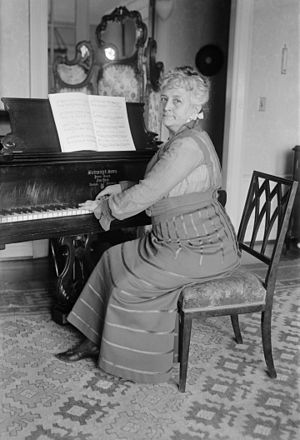
|
Teresa Carreño (December 22, 1853 – June 12, 1917) was a Venezuelan pianist, soprano and composer. Her family emigrated to the United States when she was a child, and she made her debut in a piano recital at Irving Hall in New York City at the age of eight. After giving concerts across the northeastern and mid-Atlantic United States, Carreño travelled to Europe with her family in 1866, and performed in France, Spain and Britain, occasionally taking on operatic roles. In her later career, she performed at many venues around Europe and North America, and made concert tours to Australia and New Zealand. She composed approximately 75 works for solo piano, voice and piano, choir and orchestra, and instrumental ensembles. This photograph of Carreño, taken sometime between 1915 and 1917, shows her at the piano; it is part of the George Grantham Bain Collection, held at the Library of Congress in Washington, D.C. Photograph credit: unknown; restored by Adam Cuerden
Recently featured:
|
December 23

|
Skibobbing is a winter sport involving a bicycle-type frame attached to skis. Although originally a form of transportation in the Alps, skibobbing is now a competitive sport, with contestants often achieving speeds of over 100 mph (160 km/h). This picture shows Italian skibobber Sarah Gruber, from the ASKÖ SBC Linz club, taking part in the giant slalom event at the 2018 Austrian national championships. Photograph credit: Isiwal
Recently featured:
|
December 24

|
Aida is a grand opera in four acts by Giuseppe Verdi to an Italian libretto by Antonio Ghislanzoni. Set in the Old Kingdom of Egypt, it was commissioned by Cairo's Khedivial Opera House and had its premiere there on 24 December 1871, in a performance conducted by Giovanni Bottesini. Today, the work holds a central place in the operatic canon, receiving performances every year around the world; at New York's Metropolitan Opera alone, Aida has been sung more than 1,100 times since 1886. This picture is the set design for Act 1, Scene 2, of the opera's 1871 premiere, depicting the portico of the Temple of Vulcan, designed by Philippe Chaperon. The drawing is in the collection of the Bibliothèque nationale de France. Drawing credit: Philippe Chaperon; restored by Adam Cuerden
Recently featured:
|
December 25
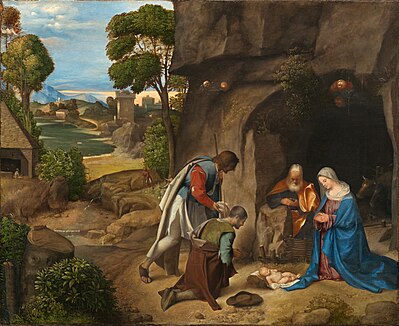
|
The Adoration of the Shepherds is an oil-on-panel painting by Italian Renaissance artist Giorgione, completed around 1505 to 1510. It depicts a common subject in the nativity of Jesus in art. The scene, based on the Biblical account in Luke 2, depicts shepherds visiting the stable to celebrate the birth of Jesus in Bethlehem. Giorgione portrayed the main characters on the right, with Saint Joseph, the Virgin Mary and the Christ Child shown in front of a dark grotto, while on the left is a bright landscape with trees, buildings and distant hills. At one time, the work was owned by the department-store magnate Samuel Henry Kress, who displayed it in the window of his Fifth Avenue store in New York City over the Christmas period in 1938. The picture was part of a donation made by the Kress Foundation to the newly established National Gallery of Art in Washington, D.C., in 1941, where it remains to this day. Painting credit: Giorgione
Recently featured:
|
December 26

|
James Russell Lowell (1819–1891) was an American Romantic poet, critic, editor, and diplomat. He was involved in the movement to abolish slavery and used his poetry to express his anti-slavery views. He was the first editor of what was to become The Atlantic and taught at Harvard University for twenty years. In 1877, he was appointed minister (ambassador) to the court of Spain and, three years later, accepted a similar role as minister to England. This picture is an engraved portrait of Lowell, produced in 1894 by John Angel James Wilcox, from an original drawing made in 1855 by Samuel Worcester Rowse. The engraving is held by the Library of Congress in Washington, D.C. Engraving credit: John A. J. Wilcox, after Samuel W. Rowse; restored by Adam Cuerden
Recently featured:
|
December 27
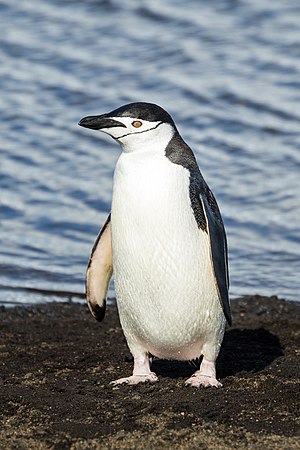
|
The chinstrap penguin (Pygoscelis antarcticus) is a species of penguin that inhabits land masses in the Southern Pacific and Antarctic Oceans. The bird's black back and white underparts provide camouflage in the form of countershading when viewed from above or below, helping it to avoid detection by its predators, which include the leopard seal, the southern giant petrel, the brown skua and the south polar skua. The chinstrap penguin grows to a length of 68–76 cm (27–30 in) and a weight of 3.2–5.3 kg (7.1–11.7 lb), with the weight varying with the time of year. Males are greater in weight and height than females. This picture shows a chinstrap penguin photographed on Deception Island, in the Antarctic archipelago of the South Shetland Islands. Photograph credit: Andrew Shiva
Recently featured:
|
December 28

|
|
Alfonso XII (1857–1885) was King of Spain from 1874 to 1885. Coming to the throne at an early age and being of a benevolent and sympathetic disposition, Alfonso won the affection of his people by fearlessly visiting districts ravaged by cholera or devastated by earthquakes. He had been suffering from tuberculosis, but the immediate cause of his death was dysentery, and he died at the Royal Palace of El Pardo on 25 November 1885, aged 27. He was succeeded by his unborn son, who became Alfonso XIII at his birth the following year. This picture shows Alfonso's funeral procession on its way from El Pardo to Madrid, engraved by Auguste Tilly for the French newspaper L'Illustration. The French text under the engraving reads 'The death of Alfonso XII – Translation of the king's body to Madrid' and 'After the sketches of Mr Campuzano, correspondent for L'Illustration'. Engraving credit: Auguste Tilly, after M. Campuzano; restored by Adam Cuerden
Recently featured:
|
December 29

|
Syed Kirmani (born 29 December 1949) is an Indian former international cricketer who represented his country as a wicket-keeper for nearly two decades. During his international career, his record included 160 catches and 38 stumpings during Test matches. He was a reliable lower-order batsman and, in the 1983 Cricket World Cup, was the recipient of the best wicket-keeper award. He partnered Sunil Gavaskar in a record ninth wicket stand, scoring an unbeaten 143 in the Madras Test. Always a central figure on the field with his closely-shaven head, he could dive and somersault to catch the ball, and was responsible for many batsmen being run out. Photograph credit: Augustus Binu
Recently featured:
|
December 30
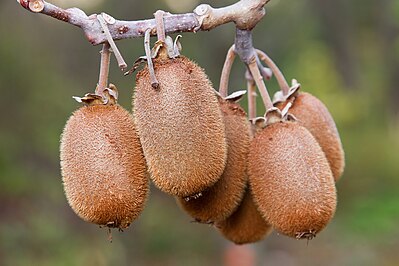
|
Actinidia chinensis is a fruit-producing vine, one of some 40 related species of the genus Actinidia, native to China. The species is a variety closely related to Actinidia deliciosa, and is the source of the common commercial kiwifruit. The plant is a vigorous climbing shrub native to China where it grows in thick oak forests, particularly on slopes and the sides of ravines. Kiwifruit were originally gathered from the wild in China for local consumption and first grown commercially in New Zealand. They are now the subject of international trade. This picture shows a few A. chinensis kiwifruit growing on a branch in Austins Ferry, in the Australian state of Tasmania. The fruit colour may vary from green to lime green or gold, depending on breeding. Photograph credit: John Harrison
Recently featured:
|
December 31

|
Beech Grove I, by the Austrian artist Gustav Klimt (1862–1918), is an oil-on-canvas painting dated 1902. It is part of a collection of about 300 paintings held by the Galerie Neue Meister in Dresden, Germany. Klimt, one of the most prominent members of the Vienna Secession movement, is best known for his opulent, symbol-laden portraits of the Viennese bourgeoisie, but his landscapes represent an important aspect of his career. For many years he travelled each summer through the Austrian and Italian countryside, painting and sketching as he went. In this work, he captures shafts of light illuminating the bare trunks of young beech trees above a litter of leaves on the forest floor. Painting credit: Gustav Klimt
Recently featured:
|
Picture of the day archives and future dates
